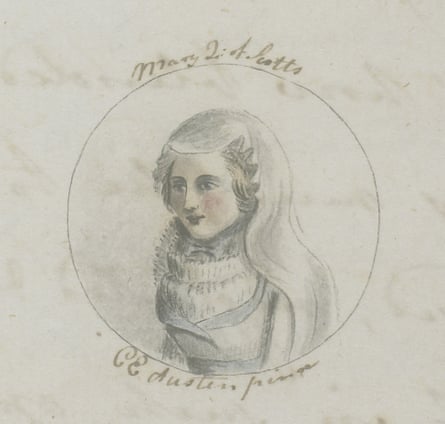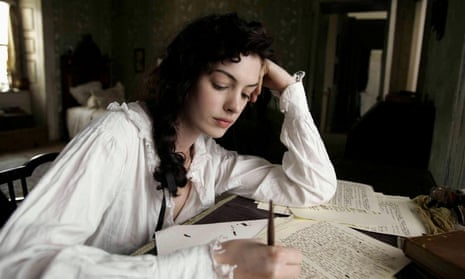“Downright nonsense” was the verdict of Mrs Augusta Bramston, a Hampshire friend and neighbour of the Austen family, on reading Pride and Prejudice. In 1814, Jane Austen published Mansfield Park, a sophisticated study of love and family life. Mrs Bramston nevertheless thought she ought to give it go, and having struggled through volume one, “flattered herself she had got through the worst”.
Jane Austen recorded this and other hilarious remarks from friends in a list of opinions on Mansfield Park. The document, in Austen’s own neat handwriting, is just one of the funny and sad items in the British Library’s new exhibition, Jane Austen Among Family and Friends, which opened on Tuesday.
Austen surely recorded the comments in a spirit of malicious mockery rather than regret. Even if only a small number of readers appreciated her at the time of her death in 1817, she hopefully knew just how brilliant a writer she was. Two hundred years later, everyone knows it. Her face is to appear on £10 notes and £2 coins, and the bicentenary of her death will see a slew of exhibitions showcasing her writing and world.
The British Library show concentrates on the handful of people who did value Austen: her family and friends. To them, she was not just an entertaining writer, but a daughter, sister and especially an aunt to her 33 nieces and nephews. Yet, while the Austens were proud of her, they couldn’t quite comprehend that she had published four well-received novels. “Every country has had its great men,” wrote her niece Caroline, “Such a one was my Aunt.” She was actually doing her best to talk up Austen’s achievements, but lacked the language with which to do so. “Great” writers were so obviously supposed to be male, and not anyone’s aunt.

Many of Austen’s stories – and some of her very earliest are on display at the British Library – were first written for family members, to be read aloud during quiet country evenings in the various parsonages, cottages and, in a few lucky cases, the mansions in which the extended Austen clan lived.
Until she published her books, Austen had no income apart from pocket money from her father or brothers. “Her whole world was her family,” explains Sandra Tuppen, the exhibition’s curator. “They gave her stability to write, she was reliant on them for money.” But with that came a sense of obligation. The exhibition contains a watercolour of Godmersham Park, her wealthy brother Edward’s mansion in Kent, where Jane spent long periods as the poor relation relied upon for cheap childcare. Once you know this, you understand how Austen the novelist used her insider-outsider perspective to skewer the vanities of the genteel world.
George Austen, Jane’s father, looms large in the exhibition. First, there’s the mahogany writing desk he bought her for her 19th birthday, which folds up into a neat, lockable box for travel. It represents a vote of confidence from the man who would act as her first, if unsuccessful, literary agent. One of the British Library’s treasures today, the desk’s drawers would have concealed the drafts of Sense and Sensibility and Pride and Prejudice.
George also purchased the notebooks in which Jane wrote out the uproarious and wicked short stories of her adolescence and teens. The notebook called “Volume the Second” contains Jane’s own handwritten version, for example, of “The Beautiful Cassandra”. The heroine falls in love, but not with a bewitching young viscount. The object of her desire is a bonnet. She steals it from a shop, before going to a confectioner’s where she “devoured six ices, refused to pay for them, knocked down the Pastry Cook and walked away”. Cassandra’s riotous adventures take place in 12 short chapters, each a sentence long: another joke was that this “novel” contained only 350 words. The three of Jane’s notebooks containing her teenage writings have been reunited by the British Library for the first time in 40 years.
But then there’s a letter from Jane to her brother Frank, telling him of their father’s death in Bath. His decease plunged his widow and daughters into financial crisis, for with George’s death their income simply stopped. From then on Jane had to live upon the charity of her brothers. “It’s a difficult society in which to be a woman,” explains Tuppen. “At one point, Jane has to stay in Kent for two months because there’s no one free among her brothers to ‘bring’ her home again.” It was not respectable to travel in a public stagecoach alone. Frank was Jane’s benefactor, but also her controller.
Every word written by Austen was published long ago, so what is there to gain from seeing the real thing? The paper, the pens, the handwriting are all important, according to Tuppen. “The kinds of book she had to write in affected how her stories grew,” she says, pointing out that all the exhibits are small, no sheet of paper wider than a handspan. Paper was expensive; Austen had to use it carefully. “You also get a sense of her as a human being, quick thinking, very witty,” Tuppen continues, pointing out one letter where she has flipped the paper to squeeze more words in upside-down.
The exhibition closes with the last of Austen’s surviving letters, dating from just a few weeks before she died. Her hand, formerly so neat, has now become a scrawl. Poignantly, Jane reassures her nephew that she’s going to get well soon. “I am gaining strength very fast,” she claims. “I am now out of bed from 9 in the morning to 10 at night - Upon the Sopha t’is true.” Within two months she would be dead, possibly from Hodgkin’s lymphoma, to be buried in Winchester Cathedral under a memorial that famously neglects even to mention her books.
Austen often took her writing desk with her from her native Hampshire to London, where she negotiated her publishing deals. Once the British Library exhibition closes, the desk itself will be moved on to Oxford to appear from 23 June in the Bodleian Library’s Which Jane Austen? exhibition. Rather than turning inward on her family, this exhibition will look at her wider world, examining her role as a professional writer in an age of war and the clashing of empires. “She lived in turbulent times,” says Kathryn Sutherland, an Austen scholar and the curator of the Bodeleian show, who beleives Austen was “our first novelist to describe the effect of war on the home front”.

That second notebook of early stories also has another journey planned: after London, it will appear from 13 May in The Mysterious Miss Austen at Winchester Discovery Centre. The book also contains Austen’s version of a Horrible Histories style parody of a pompous history textbook. Jane’s elder sister and closest confidante Cassandra illustrated it, and may have asked Jane to sit for the portrait of her favourite historical figure, Mary, Queen of Scots. You’ll be able to make up your own mind if you think the sitter is really her or not, as the exhibition focuses on the vexed issue of Austen’s physical appearance. It is “not the usual reverential fare,” says its curator Louise West, who wants the anniversary celebrations to be both “highbrow, and lowbrow”. Winchester will be the place to go to see the five best-known possible portraits of Jane Austen, each with its own supporters and detractors, gathered together for the first time.
While Janeites are pleased that she’s going to be on the banknote, many of them feel the intense irony that the image chosen by the Bank of England is a prettified, fictional author portrait produced well after her death. One of Austen’s nieces described the image as a “pleasing, sweet face”, yet confessed to “not thinking it much like the original”.
Although all these anniversary exhibitions will attempt to reveal her to the world, it’s oddly appropriate that we don’t know quite what Austen looked like. “Seldom, very seldom,” she herself warns us, “does complete truth belong to any human disclosure; seldom can it happen that something is not a little disguised.” This most mysterious of authors always holds something back – and so continues to intrigue.
Lucy Worsley’s book Jane Austen at Home will be published by Hodder in May.

Comments (…)
Sign in or create your Guardian account to join the discussion